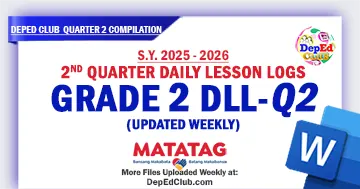- Last Updated: October 8, 2025
The Grade 2 Daily Lesson Log Quarter 2 (DLL) is an essential teaching resource that supports effective classroom instruction aligned with the DepEd MATATAG Curriculum. More than a routine planning document, it is a structured framework that translates curriculum standards into meaningful learning experiences. It ensures lessons are developmentally appropriate, sequentially organized and responsive to the needs of young learners.
At this stage, Grade 2 pupils demonstrate significant progress in literacy, numeracy and values formation. This requires lessons that are both structured and adaptable, providing opportunities for skill mastery while addressing varied learning paces and contexts. The DLL helps teachers deliver purposeful instruction while accommodating real-life situations, learner diversity and cultural relevance.
Role of the DLL in Grade 2 Instruction
The Grade 2 Daily Lesson Log Quarter 2 ensures that classroom teaching is coherent, connected and focused on achieving learning outcomes. It is not merely a compliance tool but a systematic guide that supports transitions between competencies across different subjects.
Aligned with the MATATAG Curriculum, the DLL integrates academic learning with values development. It strengthens foundational skills in reading and numeracy while also nurturing responsibility, character and cultural awareness. This holistic approach promotes inclusive and meaningful education anchored in real-life applications.
Coverage of Grade 2 DLL Quarter 2
The Grade 2 DLL Quarter 2 covers Weeks 1–8 and focuses on the following subject areas:
- English 2 DLL Quarter 2 – Enhances oral communication, phonics, vocabulary and reading comprehension. Learners begin to read fluently and analyze narrative and informational texts.
- Filipino 2 DLL Quarter 2 – Strengthens reading fluency, vocabulary and grammar, including sentence construction (simuno and panaguri). Writing and comprehension skills are developed through age-appropriate texts.
- Mathematics 2 DLL Quarter 2 – Builds mastery in addition and subtraction with regrouping, introduces basic geometry, and applies problem-solving to real-life situations.
- Makabansa 2 DLL Quarter 2 – Cultivates patriotism, respect for national symbols and awareness of community roles and responsibilities.
- GMRC 2 DLL Quarter 2 (Values Education) – Focuses on honesty, courtesy, empathy and respect through contextualized activities such as role-playing, teamwork, and reflective exercises.
Music, Arts, and Physical Education are also embedded in the DLL to ensure creativity, physical well-being and holistic learner development.

Update! Grade 2 Daily Lesson Logs – Quarter 2 (Weeks 1–8)
– MATATAG Curriculum SY 2025–2026
Access the latest DLL – 2nd Quarter Weekly Daily Lesson Logs below. These free and ready-made DLL files are carefully crafted in line with the MATATAG and MELC-based Curriculum following the most recent DepEd guidelines. Download files below for immediate use in daily lesson planning and classroom delivery. Latest DLL files uploaded weekly.
- Grade 2 MATATAG DLL – Quarter 2 – Week 1
- August 26 – 29, 2025
- Grade 2 MATATAG DLL – Quarter 2 – Week 2
- September 1 – 5, 2025
- Grade 2 MATATAG DLL – Quarter 2 – Week 3
- September 8 – 12, 2025
- Grade 2 MATATAG DLL – Quarter 2 – Week 4
- September 15 – 19, 2025
- Grade 2 MATATAG DLL – Quarter 2 – Week 5
- September 22 – 26, 2025
- Grade 2 MATATAG DLL – Quarter 2 – Week 6
- Sept. 29 – Oct. 3, 2025
- Grade 2 MATATAG DLL – Quarter 2 – Week 7
- October 6 – 10, 2025
- Grade 2 MATATAG DLL – Quarter 2 – Week 8 ( Now Available HERE )
- October 13 – 17, 2025
Need a Quick Review with Questions, Answers and Explanations / Solutions for the 2nd Periodical Tests?
Click HERE
Looking for a deeper, more detailed review for the 2nd Quarter Exams? Get ready for your 2nd Periodical Exams with our Weekly Tests and Summative Test Reviewers complete with Answer Key!
To access more focused practice and boost your exams preparation:
Visit our Weekly Test / Summative Test Reviewers ( Click HERE )
Best Practices in Using the DLL
To maximize the effectiveness of the Grade 2 Daily Lesson Log Quarter 2, teachers are encouraged to apply best practices in lesson planning and delivery:
- Contextualization – Adapt activities to reflect learners’ backgrounds, available resources, and local environment.
- Logical Sequencing – Organize lessons progressively to connect prior knowledge with new competencies for mastery.
- Integration of Bloom’s Taxonomy – Balance foundational skills (remembering, understanding) with higher-order thinking (application, analysis, creation).
- Real-Life Application – Embed lessons in everyday contexts such as household activities, school interactions, or community experiences.
- Reflective Teaching – Use the DLL as both a planning and reflection tool to refine teaching strategies and improve learning outcomes.
Also Available Grade 2 Resources – Quarter 2 SY 2025–2026
Looking for more FREE DepEd teaching resources? The following DepEd files are also updated weekly:
- Grade 2 Learning Activity Sheets (LAS)
- Grade 2 Lesson Exemplars (LE)
- Periodical Tests Quarter 2
- PowerPoint Presentations for Quarter 2
- Summative Tests for Grade 2
- and many more!
Stay updated
Follow us on Facebook to access the newest DepEd file uploads. Sharing these free resources with fellow teachers strengthens collaboration, lightens lesson preparation and fosters a more supportive teaching community.
- Follow us on Facebook for quick updates and teacher-friendly resources.
